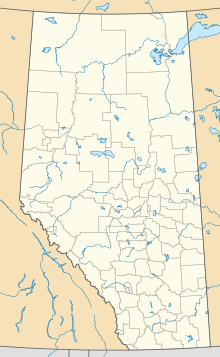Niton Junction
Niton Junction | |
|---|---|
Hamlet | |
 Location of Niton Junction in Alberta | |
| Coordinates: 53°37′19″N 115°46′11″W / 53.6219°N 115.7697°WCoordinates: 53°37′19″N 115°46′11″W / 53.6219°N 115.7697°W | |
| Country | Canada |
| Province | Alberta |
| Census division | No. 14 |
| Municipal district | Yellowhead County |
| Government | |
| • Type | Unincorporated |
| • Mayor | Jim Eglinski |
| • Governing body | Yellowhead County Council
|
| Area | |
| • Total | 0.91 km2 (0.35 sq mi) |
| Elevation | 845 m (2,772 ft) |
| Population (2016)[1] | |
| • Total | 38 |
| Time zone | UTC−7 (MST) |
| • Summer (DST) | UTC−6 (MDT) |
Niton Junction is a hamlet in west-central Alberta, Canada within Yellowhead County.[2] It is located on the Yellowhead Highway (Highway 16) approximately 45 kilometres (28 mi) east of Edson and 150 kilometres (93 mi) west of Edmonton. It is east of the Yellowhead Highway's junction with Highway 32 and west of Chip Lake. Niton Junction has an elevation of 845 metres (2,772 ft).
Statistics Canada recognizes Niton Junction as a designated place.[3]
The hamlet is located in Census Division No. 14 and in the federal riding of Yellowhead.
Demographics[]
As a designated place in the 2016 Census of Population conducted by Statistics Canada, Niton Junction recorded a population of 38 living in 15 of its 15 total private dwellings, a change of 46.2% from its 2011 population of 26. With a land area of 0.91 km2 (0.35 sq mi), it had a population density of 41.8/km2 (108.2/sq mi) in 2016.[1]
In the 2011 Census, Niton Junction had a population of 26 living in 11 of its 11 total dwellings, a -78.2% change from its 2006 population of 119. With a land area of 1.01 km2 (0.39 sq mi), it had a population density of 25.7/km2 (66.7/sq mi) in 2011.[3]
See also[]
References[]
- ^ a b c "Population and dwelling counts, for Canada, provinces and territories, and designated places, 2016 and 2011 censuses – 100% data (Alberta)". Statistics Canada. February 8, 2017. Retrieved February 13, 2017.
- ^ "Specialized and Rural Municipalities and Their Communities" (PDF). Alberta Municipal Affairs. January 6, 2021. Retrieved September 29, 2021.
- ^ a b "Population and dwelling counts, for Canada, provinces and territories, and designated places, 2011 and 2006 censuses (Alberta)". Statistics Canada. 2012-02-08. Retrieved 2012-04-07.
- Designated places in Alberta
- Hamlets in Alberta
- Yellowhead County
- Central Alberta geography stubs
